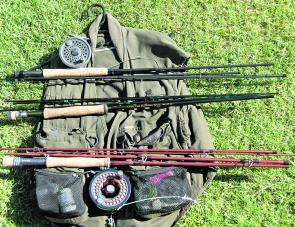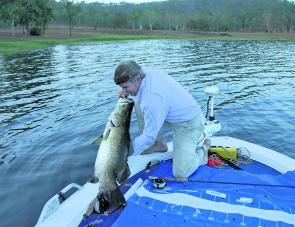In this article I’m heading back to basics to answer a few email enquiries I have received from anglers thinking of taking up flyfishing.
What goes round comes round and at the moment it seems that flyfishing is having somewhat of resurgence. I’ve seen this several times since I took up this specialized form of angling almost five decades ago, and these cycles make sense if we look at the big picture. Anglers’ pursuits evolve as their life opportunities advance and become clearer. Time to work, time to play, and for many the latter pursuit means fishing, which progresses from bait to lures, and for many the next step is fly. And each year more and more anglers join our ranks and explore the possibilities of flyfishing.
With a host of online and media outlets providing information and tuition on angling and its varying techniques and pursuits it’s easier than ever for anglers to learn and evolve their angling abilities and knowledge. With bait and lure techniques mastered its only logical that many anglers then evolve towards flyfishing as their next must-do pursuit. One of the purist traditions of angling and a style of fishing that’s equal parts beauty, timing and power, flyfishing is a style of angling that can be used to catch fish big and small, and in the salt and the fresh.
There’s a bit more to taking up fly fishing than just buying a rod, reel, line, leader and fly and heading to your local waterway to catch fish. The first piece of the puzzle is the rod. In flyfishing the rod and line work together and as a result selecting a rod then matching it with the correct line is essential for the casting process to work.
Fly rods are categorized in ‘weights’, which has nothing to do with what a rod actually weighs in the hand. Instead it refers to the weight, in grains, of thirty feet (9.144 m) of a selected fly line. The system is part of a Standard Line Weight scale set up to standardize fly tackle manufacturing across the US tackle industry, and from which the world seems to take it’s lead.
So what are Grains? Grains are an avoirdupois or imperial unit of weight within a measurement system that we Aussies no longer use but still exists in the US. Accordingly, fly lines are still measured in grains and have a standardized weight with rods also weighted to match them.
So we have very light fly rods in sizes 3, or 4, with their line’s weight (in grains) of 100 and 120 respectively for that set length. These are slim rods, extremely light in the hand and are a dream to use on fish such as gar, spangled perch, small bass and trout. As the target fish increase in size or the fly increases in size, or perhaps a combination of both (flathead and big streamer flies come to mind), there’s a need for a more solid fly rod, with 7 or 8 weight rods a common step up in size, with their matching fly lines packing 185 and 210 grains respectively into that specified amount of fly line.
When it comes to even larger fish, 9 and 10 weight (or larger) gear becomes the norm, and the importance of matching the rod, reel and line increases once again, especially when it comes outfit cast-ability. Incorrect, unmatched and unbalanced outfits result in inefficient and tiresome casting, and compromise fight power and performance, all important factors when fight large, hard fighting fish.
I like to think of barra, my all time favourite fish on fly. While I may use a 9-weight rod when chasing barra in areas that have fish no bigger than 90cm, in locations where big fish prevail (Kinchant and Peter Faust dams, Hinchinbrook Channel) a 10 weight is more the go. This horse for course approach illustrates perfectly the need to match the right outfit to the right application.
Putting tackle weight to the side, but remembering the vital need for balance between rod and line, the next issue is price. Just like it is with most tackle purchases there is no substitute for quality gear to yield quality results, especially when it comes to casting, which is arguably the most important of the fly angler’s skills. While I’m not suggestion that a beginner should go straight to the top shelf when buying tackle, buying the best outfit you can afford will help maximise you casting ability and performance, and of course fishing success.
Knowledge and experience with assessing tackle can only be gained from a lot of time. In lieu of this, tackle store staff well versed in flyfishing is your best resource when it comes to choosing tackle. Also having the ability to cast with an outfit before purchasing it is a huge start to a successful acquisition.
With a quality multi piece rod, saltwater capable fly reel, backing and weight forward fly line tucked under your arm it’s time to start practice casting on the lawn or on the water. Watching some online videos of casting is a worthy precursor to hitting the park or water. Small casts are where you want to begin, longer ones come with confidence, and when timing is mastered to perfection.
I’m sometimes asked about online purchasing. For the beginner it’s very dicey unless he or she knows precisely what is being ordered and that it will fill the bill. A lot of online fly tackle ends up being resold not long after it’s first purchased because it did not fulfil requirements. So there can be elements of risk involved.
Fly angling has been going on for centuries, yet it is still evolving with more material, new flies coming to light, and new species being identified as a fly species. Despite this evolution a few thing remains the same, namely the importance of balanced tackle and the need to learn to how to make a long flat cast with minimal back casts. The later is always so much easier when the rod and line work in harmony. It makes life easier and helps make you a better fly angler.
Reads: 4281
This selection of fly rods shows a four weight uppermost, ten weight lowest with an eight weight in between. Note the difference in thickness of these rods.

Big fish demand big tackle: that’s a 114cm barra taken on a 10 weight rod and matching reel.

Smaller fish, smaller gear: this brown trout was taken on a four-weight outfit.




